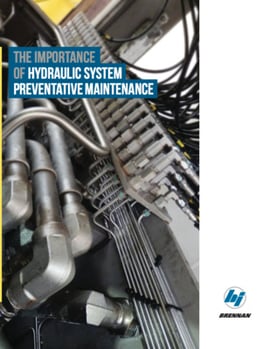Hydraulic fluids are formulated with additives developed for the specific application. These additives are typically made by companies who specialize in petroleum based materials. Additive manufactures develop specialized additives made specifically for hydraulic oil for construction equipment. The additives consist of chemical compounds that protect the base stock of natural mineral oil-based fluids.
Hydraulic Fluid Contamination Testing
For certain equipment that is more sensitive or regularly exposed to dirty environments such as construction machinery, it is vital to have well organized contamination control procedures. This includes periodic testing of the cleanliness of the hydraulic fluid by following the OEM’s recommendations. There should also be filters placed at regular intervals in the system to block contaminant that can work their way into the line.Testing the fluid is performed in-line with test point fittings placed at regular intervals throughout the system. Well designed test point connections are leak-proof before the ball check is open; this along with the self-locking metal cap minimizes the risk of back flow contamination into the system. Testing fluids in-line permits sampling at working pressure without disrupting the system’s operation. Otherwise the equipment must be shut down for extra maintenance outside of the normal planned maintenance schedule. Most maintenance professionals maintain a full line of test point components, or a variety of test point kits. The kits include all styles of connections, test hoses, couplings, pressure gages, gage adapters, plugs and probes. Having multiple styles of test points available makes it easy for periodic testing of a wide variety of OEM equipment.Hydraulic fluid testing should be performed after new fluid is added, new components or hoses are placed in line or any other situation that may expose the fluid to the environment. It is often overlooked that new fluid straight from the supplier can cause hydraulic fluid contamination.
Hydraulic Fluid Systems Quality - How to Monitor & Avoid Contamination
Contamination control techniques involve diagnostics and treatment of the system. Diagnostics, or ‛Condition Monitoring’, involves measuring and identifying the condition of the fluid and system components. As much as three-quarters of hydraulic systems fail due to contaminated or old fluid. The system can be contaminated by solid particles or liquids. Even water is a major cause for concern. Clean fluid promotes longer component life and increases uptime. This ensures more reliable equipment, reduces unplanned maintenance and costly component repair or replacement.Equipment is more isolated from the elements in a manufacturing plant, though contaminants still cause 60% to 70% of all hydraulic failures. Yet in construction, particularly earthmoving equipment, as much as 85% to 90% of all failures can be from fluid contamination. If particles get into an engine or other critical components the service life of the equipment can be reduced by as much as 60% to 75%. Contaminative particles and moisture typically enter through air intakes on the engine of construction equipment.
A Few Solutions for Your Contamination Control Plan:
- Supplemental Bypass Filters can double engine fluid cleanliness
- Desiccating Breathers increase filtration to protect against extremely small particulates that other filters may miss
- Corrosion Prevention is enhanced by the use of rust inhibitors in the hydraulic fluid which place protective films on metal parts

Conclusion: Equipment Uptime Impacts the Bottom Line
Hydraulic fluid contamination control is crucial for the operation and extended life of a hydraulic system. In order to extend the service life and ensure smooth operation of equipment, maintenance engineers must understand, identify and regularly measure the system for potential contaminants. These preventative maintenance steps can make a huge impact on maintenance costs, equipment uptime and overall profitability of the job.
To learn more about avoiding hydraulic fluid contamination and preventative maintenance techniques, download our white paper:
If you're interested in our line of Test Points, click here to download our catalog.
You can also view our product collection on our website by clicking here.
Sources:
- Design World
- Engineers Edge
- Equipment World
- ForConstructonPros.com
- Hydraulics & Pneumatics 6430
- Hydraulics & Pneumatics 6436
- Hydraulics & Pneumatics-test-point-fittings-1
- IDCON, Inc.
- International Organization for Standardization
- Machinery Lubrication
- Mobil Industrial Lubricants
- Reliabilityweb.com
- The Heavy Duty Manufacturers Association
- The Society of Tribologists and Lubrication Engineers (STLE)

